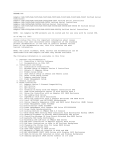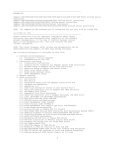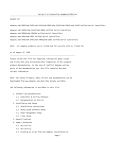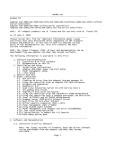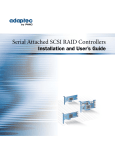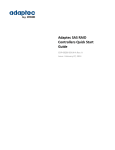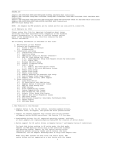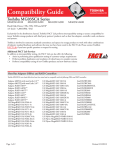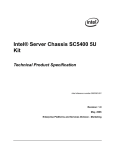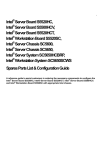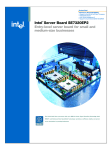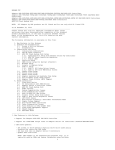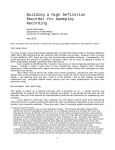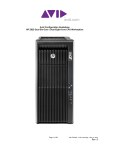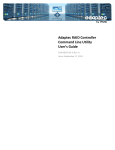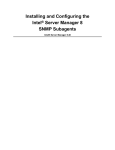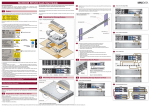Download Adaptec 6405 User`s guide
Transcript
-------------------------------------------------------------------README.TXT
Adaptec ASR-6405/ASR-6445/ASR-6805/ASR-6405E/ASR-6805E Unified Serial Controllers
Adaptec ASR-6805Q/ASR-6405T/ASR-6805T/ASR-6805TQ Unified Serial Controllers
NOTE:
All Adaptec by PMC products are UL listed and for use only with UL listed ITE.
as of November 30, 2011
-------------------------------------------------------------------Please review this file for important information about issues
and errata that were discovered after completion of the standard
product documentation. In the case of conflict between various
parts of the documentation set, this file contains the most
current information.
NOTE: The latest firmware, BIOS, drivers and documentation can be
downloaded from www.adaptec.com when they become available.
The following information is available in this file:
1. Software and Documentation
1.1 Controller & Utility Software
1.2 Documentation on this DVD
2. Installation and Setup
2.1 Installation Instructions
2.2 Windows Setup on Adaptec Series 6 Controllers
2.3 Solaris 11 Express Setup
2.4 SCSI Device Setup on Debian and Ubuntu Linux
2.5 Other Linux Setup Issues
2.6 Adaptec maxCache Setup
2.7 Power Management Setup
3. General Cautions
4. Known Limitations
4.1 ACU Utility
4.2 AFU Utility
4.3 Creating an Array from the Adaptec Installation DVD
4.4 SuSE Linux Enterprise Server 10 with Service Pack 2
4.5 Using the Controller with an Adaptec S50 JBOD Enclosure
4.6 Hot-adding Disk Drives
4.7 SuperMicro Disk Drive Enclosures
4.8 Intel SE7525RP2 and SE7320EP2 Motherboards
4.9 Online Capacity Expansion (OCE) and RAID Level Migration (RLM) Issues
4.10 OCE/RLM Limits and Restrictions
4.11 Power Management under FreeBSD
4.12 Failed Arrays under FreeBSD
4.13 Power Management with Seagate SAS Drive ST31000640SS
4.14 Linux Cache Synchronization
4.15 Listing Devices in VMware ESX 4.0 Console
4.16 BIOS Hangs When Booting RAID Controller with Batteryless Backup (ZMCP)
4.17 Updating Firmware on Hitachi HUS1514xxVLS300 SAS drives
4.18 Installing Windows OS from Direct-Attached Non-DASD Device
4.19 maxCache SSD Cache Performance
4.20 Exceeding 2TB LUN Size on VMware ESX Server
4.21 Changing the Stripe Size for Large RAID Arrays
4.22 Hot-Adding maxCache SSDs
4.23 Some SSDs Appear as SATA Drives
4.24 Mismatch in RAID x0 creation in BIOS and ASM
4.25 WDC WD3200BJKT-00F4T SATA Drives with Promise J630 Enclosures
4.26 SATA 6G Drives Not Detected on Intel and Promise Backplanes
4.27 Samsung Spinpoint SATA Drives Timeout on I/O Load
4.28 RAID Array Creation Issue With STEC MACH 8 SSDs
4.29 Dual-Port SATA Enclosures
4.30 Xtore and Xyratex Enclosure Timeout
4.31 Boot delay with Plextor PX-716SA DVD-ROM Drive
4.32 Series 6 Controllers Hang on Warm Reboot on Some ASUS Motherboards
4.33 HDA Mode Reset for Adaptec Series 6 Controllers
-------------------------------------------------------------------1. Software and Documentation
1
1.1. Controller & Utility Software
- Adaptec Firmware/BIOS/Driver/Utilities Version 7.3
NOTE: The latest versions of firmware, BIOS, driver software and
utilities can be downloaded from the Adaptec Web Site at
www.adaptec.com.
- Drivers on this DVD
The drivers on this DVD have been tested and certified on
the following operating systems. In general, you can load
the drivers on out-of-box operating system versions, the
latest service pack, or software update. Compatibility
issues may be seen with untested OS versions.
NOTE: Not all operating systems are supported by all
controllers. See notes below.
- Windows Drivers
o
o
o
o
Windows
Windows
Windows
Windows
Server 2008, 32-bit and 64-bit
Server 2008 R2, 64-bit
Vista, 32-bit and 64-bit
7, 32-bit and 64-bit
- Linux Drivers
o
o
o
o
o
o
o
Red Hat Enterprise Linux 5.5, IA-32 and x64
Red Hat Enterprise Linux 6.0, IA-32 and x64
SuSE Linux Enterprise Server 10, IA-32 and x64
SuSE Linux Enterprise Server 11, IA-32 and x64
Debian Linux 5.0.7, 6.0, IA-32 and x64
Ubuntu Linux 10.10, 11.04, IA-32 and x64
Fedora Linux 12, 13, 14, IA-32 and x64
- FreeBSD Drivers
o FreeBSD 7.4, 8.2
- VMware Drivers
o VMware ESX 4.1 Classic
o VMware ESXi 5.0
- Sun Solaris Drivers
o Solaris 10
o Solaris 11 Express*
*Not Supported on Bootable Arrays; see Section 2.3
1.2. Documentation on this DVD
-
Adaptec
Adaptec
Adaptec
Adaptec
SAS RAID Controllers Installation and User's Guide
RAID Controller Command Line Utility User's Guide
SAS RAID Controllers Quick Start Guide
SAS RAID Controllers README.TXT file
-------------------------------------------------------------------2. Installation and Setup
2.1
Installation Instructions
The Adaptec SAS RAID Controllers Installation and User's Guide
contains complete installation information for the controllers
and drivers, as well as complete instructions for all
utilities. The Adaptec Storage Manager User's Guide
contains complete installation information for the Adaptec
Storage Manager software.
2
2.2
Windows Setup on Adaptec Series 6 Controllers
On Windows 2008 R2 64-bit systems, the Setup program tries to load
Inbox storage drivers first, by default. As a result, you must load
the driver for Adaptec Series 6/6Q/6E/6T controllers TWICE.
The first time you load the driver, the OS displays the message
"No drives were found'. Select 'Load Driver' again, uncheck "Hide
drivers that are not compatible...', then select the Series 6
controller driver. On the second attempt, the driver will load
successfully.
2.3
Solaris 11 Express Setup
Installing Solaris 11 Express on a bootable array is not
supported in this release.
2.4
SCSI Device Setup on Debian and Ubuntu Linux
o After installing the Debian Linux driver, you must replace the
SCSI Device Partition Name in Debian’s GRUB bootloader with
a UUID. Failure to update the partition name may cause the
system to hang when the OS is rebooted. In the GRUB bootloader
file "menu.lst", replace the SCSI device partition name
(for instance, /dev/sda1), with UUID=<string>.
o After installing the Ubuntu Linux driver, you must increase
the SCSI command timeout value from 30 seconds (the default
value) to 90 seconds. Failure to increase the timeout may
cause the system to hang with a EXT4 error when a good drive
is removed from a rebuilding array. Use these commands to
increase the timeout in SYSFS, assuming /dev/sda, /dev/sdb,
and /dev/sdc are the device LUNs on the Ubuntu Linux host:
echo ``90``> /sys/block/sda/device/timeout
echo ``90``> /sys/block /sdb/device/timeout
echo ``90``> /sys/block/sdc/device/timeout
2.5
Other Linux Setup Issues
Before installing the Linux operating system on a logical drive,
be sure to clear (remove) old data first. If you do not
remove old data prior to installation, the OS may not boot.
As a workaround, use the boot parameter 'aacraid.wwn=2'.
2.6
Adaptec maxCache Setup
o Adaptec maxCache SSD caching is supported on Adaptec Series Q
controllers only.
o Adaptec Series Q controllers support any maxCache-compatible
SSD on the compatibility list; see www.adaptec.com/compatibility
for a full list of compatible SSD drives.
o You can install a maximum of 8 SSDs on a controller for
maxCache caching applications.
See the user's guide for complete maxCache SSD installation and
setup instructions.
2.7
Power Management Setup
You must use a compatible combination of Adaptec Storage Manager
and controller firmware and driver software to use the power
management feature. All software components must support power
management. You can download the latest controller firmware
and drivers from the Adaptec Web site at www.adaptec.com.
-------------------------------------------------------------------3. General Cautions
3
- While an array is builing or cleared, do not remove and
re-insert any drive in that array. Doing so may cause
unpredictable results for any arrays on the controller.
- Do not move drives containing an array from one controller
to another while the power is on. Doing so could cause
the loss of the array configuration or data, or both.
Instead, power off both affected controllers, move the
drives, and then restart.
-------------------------------------------------------------------4. Known Limitations
4.1
ACU Utility
o ACU for DOS is deprecated and no longer supported.
o For degraded arrays on Adaptec Series 6E controllers, the ACU
displays "junk' characters in the array properties list for
the missing drive.
o On some Intel and IBM systems, when you try to run the ACU
utility, this message appears:
"Not enough free memory to load the utility!
Press any key to attempt loading the utility forcibly
OR Wait for the system initialization to be completed
[Default]"
This is normal. On Intel systems, wait for the system
initialization to be completed. Then the ACU will run. On IBM
systems, press any key when prompted to load the utility
forcibly.
o The ACU erroneously displays deleted logical drives in the
JBOD list. The logical drive(s) continue to appear in the
JBOD list until you delete all of the JBODs.
o With some enclosures, the ACU displays incorrect box/slot
information for managed disk drives; for example,
Exp/Phy instead of Box/Slot.
4.2
AFU Utility
When running the AFU in Menu Mode, you can update (flash) only
one controller at a time. You must reboot the system before
updating the next controller.
4.3
Creating an Array from the Adaptec Installation DVD
When you create an array with Adaptec Storage Manager in
bootable-CD Mode, the maximum size of the array is 2TB.
4.4
SuSE Linux Enterprise Server 10 with Service Pack 2
If your boot array is installed on the controller, and the boot
OS is SLES10 SP2 with driver version 1.1.5-2458, you must add
'aacraid.wwn=1' to the kernel boot command line. Alternatively,
install the latest aacraid driver.
4.5
Using the Controller with an Adaptec S50 JBOD Enclosure
Temperature warnings from the Adaptec S50 JBOD Enclosure with
firmware version T016 are not shown in Adaptec Storage Manager
(or on the enclosure). To correct the problem, upgrade to the
latest firmware version.
4.6
Hot-adding Disk Drives
o
If you hot-add multiple disks to a large configuration (100
disk drives or more), it may take a significant amount of
4
time before those disk drives appear in Adaptec Storage Manager.
o With Intel Backplanes AXX4DRV3GEXP and AXX6DRV3GEXP, if a drive
bay is empty when the enclosure is powered up, then a SATA disk
drive is hot-added into the empty bay, the controller does not
detect the new disk drive. To work around this issue, remove
and re-insert the SATA drive.
4.7
SuperMicro Disk Drive Enclosures
o Due to an auto backplane detection issue with SuperMicro
SC836TQ enclosures, the red fault LED does not go on when
a failed member of an array is pulled from the enclosure,
for both SGPIO and I2C modes. WORKAROUND: Use the BIOS
utility to force the backplane type to I2C or SGPIO.
o If the controller does not detect disk drives installed in a
SuperMicro M28E2 Mobile Rack, use backplane SAS connectors
marked with "SAS In" only.
4.8
Intel SE7525RP2 and SE7320EP2 Motherboards
The Intel SE7525RP2 and SE7320EP2 motherboards do not support
Mode 0 flash. These motherboards use 64-bit PCI addressing.
The AFU currently supports 32-bit PCI addresses only.
4.9 Online Capacity Expansion (OCE) and RAID Level Migration (RLM) Issues
o The system may fail to boot after performing a boot drive OCE/RLM.
To correct the problem, verify that the boot drive is still
listed as the first logical device in Adaptec Storage
Manager (ASM). If not, use the BIOS utility to reselect the
proper boot device.
o After performing an OCE on a Solaris 10 U9 system, the OS
may fail to start if you pull a drive from the reconfigured
logical device before rebooting.
o Removing a member of an array while an OCE is in progress
can cause the array to be deleted.
NOTE: We strongly recommend that you do not remove any drive
during an OCE/RLM.
4.10 OCE/RLM Limits and Restrictions
This release supports a maximum of 8 concurrent OCE tasks in
the RAID array migration wizard. The following RAID-Level
migrations (RLM) and Online Capacity Expansions (OCE) are NOT
supported:
o RAID 50 to RAID 5 RLM
o RAID 60 to RAID 6 RLM
o RAID 50 to RAID 60 OCE
4.11 Power Management under FreeBSD
The FreeBSD driver does not support power management in
this release.
4.12 Failed Arrays under FreeBSD
o On FreeBSD 7, deleting an array under IO load causes the
OS to reboot automatically.
o On FreeBSD 8, if an array fails (including pulling a drive
from the array), the firmware may crash causing the OS to
hang or reboot automatically.
4.13 Power Management with Seagate SAS Drive ST31000640SS
5
Power Management is not supported by the Seagate ST31000640SS
SAS drive. (The drive powers down but will not power up without
rebooting.)
4.14 Linux Cache Synchronization
With Linux driver 1.1-5-2459 (or higher), you may see an improvement
in performance if you suppress cache synchronization. For a
controller with battery back-up, add 'options aacraid cache=6' to
the /etc/modprobe.conf.local file. To completely suppress cache
synchronization, add 'options aacraid cache=2'. Then, reboot.
Note that the smaller value provides no protection in case of a
power outage.
4.15 Listing Devices in VMware ESX 4.x Console
After deleting an array with ARCCONF, the VMware ESX Console
will hang if you list devices with the 'fdisk -l' command.
As a work-around, rescan first, then try 'fdisk -l'.
4.16 BIOS Hangs When Booting RAID Controller with Batteryless Backup (ZMCP)
Possible Causes: After a system shutdown, the ZMM-100DB daughterboard
remains active for several minutes. The Super Cap connector may have
been improperly removed and/or re-inserted with a charge still present.
Solution: Plug the Super Cap connector in when the system is off
and, if the yellow activity LED is illuminated on the ZMM-100DB
daughterboard attached to RAID Controller, wait for the LED
activity indicator to go out. This may take several minutes.
The system should then boot normally.
4.17 Updating Firmware on Hitachi HUS1514xxVLS300 SAS Drives
Firmware upgrade on Hitachi HUS151473VLS300 and HUS151436VLS300
SAS drives is not supported for packet sizes below 4K (512/1024/2048).
4.18 Installing Windows OS from Direct-Attached Non-DASD Device
Adaptec RAID controllers do not support Windows OS installation from
direct-attached Non-DASD devices ("Direct Access Storage Devices"),
such as a tape drive, CD-ROM, or DVD-ROM. Adaptec recommends
using a motherboard IDE or SATA DVD-ROM/CD-ROM device to install
the Windows OS on a RAID array.
4.19 maxCache SSD Cache Performance
The maxCache cache contents is lost if the OS is not shut down
cleanly (for example, by pressing the reboot button or
pulling the power). When the system is restarted, the cache
is rebuilt. Until that time, you may see a temporary loss
in performance.
4.20 Exceeding 2TB LUN Size on VMware ESX Server
Under VMware, if you create a logical drive with greater than
2TB of capacity, the OS will only be able to access the remaining
storage above 2TB. For instance, with the 3.5TB LUN, only
1.5TB will be accessible; with a 5TB LUN, only 1TB will
be accessible (first 2TB+2TB are skipped); and so on.
4.21 Changing the Stripe Size for Large RAID Arrays
For large RAID arrays, a RAID-level migration may fail with a
firmware crash if you reconfigure the array with a different
stripe size. No data is lost, however.
Known migrations that result in a FW crash include:
o 16/32/64/128 drive R0- 256/16 to 16/256 stripe change
o 16/32/64/128 drive R0- 512/16 to 16/512 stripe change
6
o
o
o
o
16/32/64/128 drive R0- 1024/16 to 16/1024 stripe change
16/32 drive R5- 16 to 512/1024 stripe change
16/32 drive R5- 512/1024 to 16 stripe change
16/32 drive R6- 1024/16 to 16/1024 stripe change
4.22 Hot-Adding maxCache SSDs
If you remove two or more maxCache SSDs then re-insert the
drives at the same time, only one will be recognized as part
of the maxCache pool. To reconstitute the pool, use Adaptec
Storage Manager or the BIOS utility to reconfigure
the maxCache cache.
4.23 Some SSDs Appear as SATA Drives
Some solid state drives (such as the MemoRight MR25.2-S032G)
identify themselves as ROTATING media. As a result, these SSDs:
o Appear as SATA drives in the ASM Physical Devices View
o Cannot be used as Adaptec maxCache devices
o Cannot be used within a hybrid RAID array (comprised of
SSDs and hard disks)
4.24 Mismatch in RAID x0 creation in BIOS and ASM
The BIOS utility creates RAID x0 arrays with an odd number of
drives by default. Adaptec Storage Manager creates RAID x0
arrays with an even number of drives by default.
4.25 WDC WD3200BJKT-00F4T SATA Drives with Promise J630 Enclosures
A compatibility issue between Western Digital WD3200BJKT-00F4T
SATA drives and Promise J630 enclosures can result in a firmware
crash during a RAID array build or bus rescan.
4.26 SATA 6G Drives Not Detected on Promise and Intel Backplanes
o With Promise J830s enclosures, SATA 6G drives are reported as
3G in ASM and the BIOS utility, due to a speed negotiation
issue between the drive and the expander.
o With Intel AXX6DRV3G and AXX6DRV3GEXP backplanes, SATA 6G drives
are not detected in the BIOS. With Intel AXX6DRV3G backplanes,
the BIOS hangs; with Intel AXX6DRV3GEXP backplanes, no drives
are detected in the BIOS utility.
4.27 Samsung Spinpoint SATA Drives Timeout on I/O Load
With Samsung Spinpoint SATA drives, models HD103UJ/HD103UI/HE103UJ,
the controller can reset due to a timeout when the drive is under
heavy I/O load.
4.28 RAID Array Creation Issue With STEC MACH 8 SSDs
With STEC MACH 8 SSDs with firmware version 1766, RAID array
creation fails when using the Adaptec Storage Manager wizard.
WORKAROUND: Upgrade to the latest STEC firmware version to
resolve the problem.
4.29 Dual-Port SATA Enclosures
Dual-ported SATA enclosures are not supported in this release.
However, on Series 6 controllers (only), redundant paths to SATA
disks are detected in the firmware, but treated and shown (in ASM,
BIOS, etc) as two single path enclosures with the correct number
of drives. Although the drives are shown as available for
configuration, the configuration will fail. The firmware
currently supports dual path SAS drives only.
NOTE: Mixing SATA and SAS drives in the same logical device
is not recommended.
7
4.30 Xtore and Xyratex Enclosure Timeout
With Adaptec Series 6 controllers, Xtore XJ-SA12-005
and XJ-SA26-224R-S enclosures timeout when they receive a
Diagnostic Page 04 command. The error occurs at approximately
10 minute intervals (and is reported in the ASM controller
log file), but has little or no effect on performance.
4.31 Boot delay with Plextor PX-716SA DVD-ROM Drive
When booting from a Plextor PX-716SA DVD-ROM drive attached
directly to an Adaptec controller, the boot appears to fail
with a "Could not find boot CD-ROM" error, but resumes
and boots successfully if you wait approximately 30 seconds
or until the front LED light turns green.
4.32 Series 6 Controllers Hang on Warm Reboot on Some ASUS Motherboards
Due to a PCIe configuration problem with ASUS P7P55-WS, KCMA-D8,
and KGPE-D16 motherboards, Adaptec Series 6 controllers may hang
on warm reboot if installed in a slot with x8 links.
WORKAROUND: Use a slot with x16 links.
4.33 HDA Mode Reset for Adaptec Series 6 Controllers
Adaptec Series 6 controllers do not support Mode 0 reset, using
the AFU utility on the Adaptec Installation DVD. To flash
a Series 6 controller using the HDA mode jumper on the controller
board, you must use the PFU.exe utility, which uses a FDL
firmware file (as opposed to a UFI file) to reset the board.
PFU.exe is available only from your Adaptec by PMC service
representative; it is not included on the installation DVD. For
the location of the HDA jumper on Series 6 controllers, see the
user's guide.
-------------------------------------------------------------------(c) 2011 PMC-Sierra, Inc. All Rights Reserved.
This software is protected under international copyright laws and
treaties. It may only be used in accordance with the terms
of its accompanying license agreement.
The information in this document is proprietary and confidential to
PMC-Sierra, Inc., and for its customers' internal use. In any event,
no part of this document may be reproduced or redistributed in any
form without the express written consent of PMC-Sierra, Inc.,
1380 Bordeaux Drive, Sunnyvale, CA 94089.
P/N DOC-01699-01-A Rev A
8








